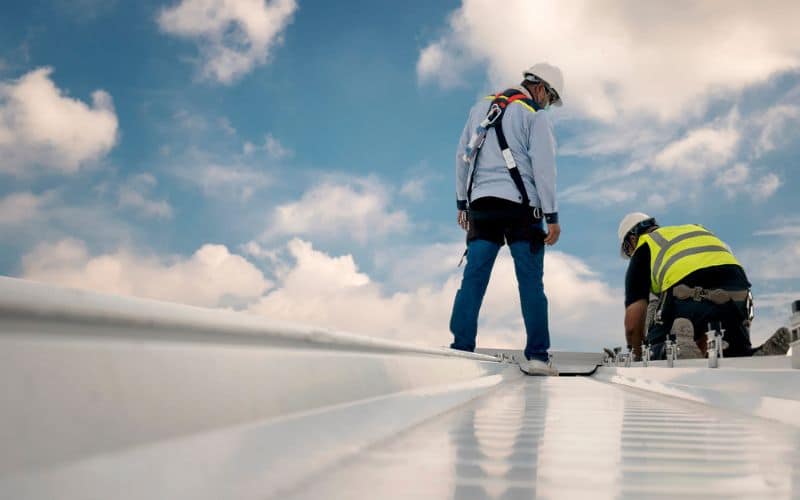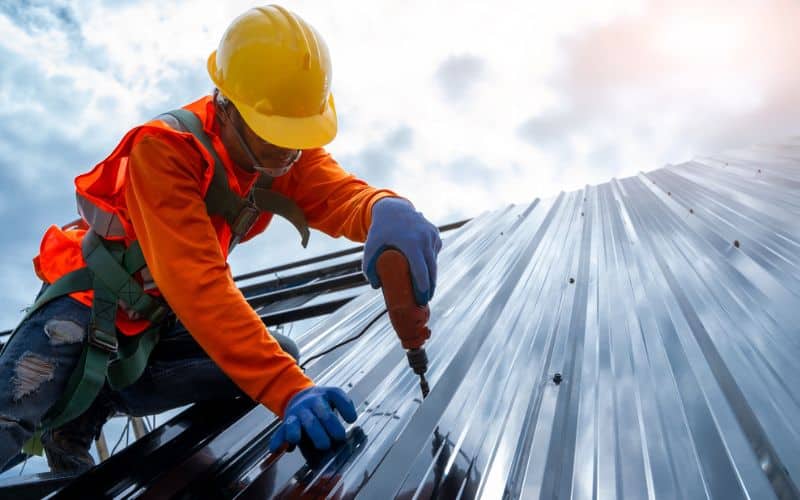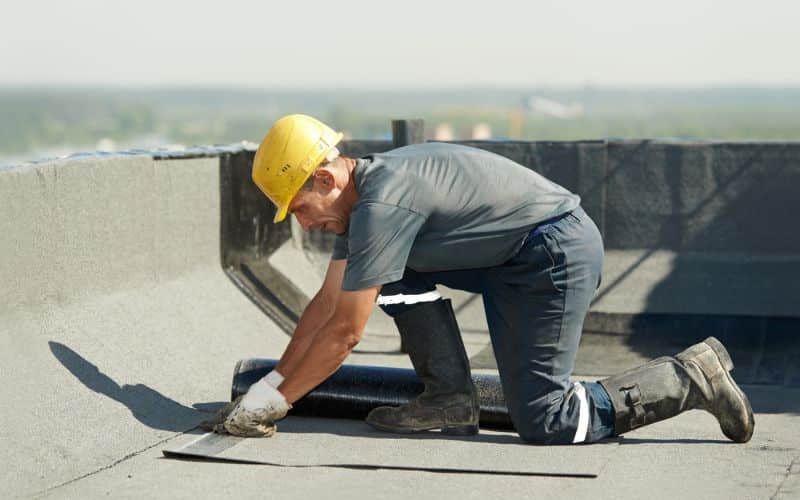500 Hood Road, Suite 320Markham ONL3R 9Z3

Many commercial building owners are unaware of how important good care of their commercial roofing system and flat roof is. It's easy to ignore a roof, since you don't really look at it daily, and it's hard to see the wear and tear.
However, not having regular inspections and not conducting routine maintenance to find and fix minor roof issues early on, before they deteriorate into significant damage, means more costly repairs, risks to structural integrity, and even a premature total roof replacement. Most commercial roofs are designed to last anywhere from 15 to 30 years, but this doesn't mean they don't need maintenance, and they won't last their full term without care.
A commercial roof is expensive, so it makes sense to inspect and maintain it, so you get the most possible use out of it. Below are some roof maintenance tips, to help you make sure you are caring for your flat roof effectively.
Firstly, be sure you are maintaining your entire roof. Commercial roof maintenance needs to include all elements of roofing systems, including membranes and parts of the system that can't be visually inspected. This means going beyond noting visible signs of damage and repairing them, to looking for indirect symptoms of roof issues, such as water damage. A roofing professional who specializes in commercial roof inspection can help identify areas that need repair and make recommendations.

If you are not inspecting your roof for hidden and visible damage, minor issues will go unnoticed, and these little problems will be allowed to deteriorate into major issues. Manufacturers and professional roofing contractor organizations recommend biannual or at least annual roof system inspections, making sure to complete any noted repairs needed, to extend your commercial roof's longevity significantly. Inspecting after the extremes of winter weather and summer heat is best.
Checking for holes, tears, cracks and blisters, as well as other damages or warning signs of issues, like roofing material pulling away, helps identify early damage for timely repairs. Don't forget to check roof flashing, which covers any openings to prevent water leaks, which can deteriorate, pull away, or get punctured.
A professional inspection helps ensure all potential issues are identified early and prioritized for repair.
After severe storms, be sure to check for loose flashing, standing water afterwards, and other signs.
Even if you don't notice anything damaged on your roof, watch for other signs there may be roofing problems, like water or moisture damage on interior walls, including mold and mildew. Don't forget to check ceilings and attics.
Check all flashing, and look at vents, fascias, chimneys, drip edges and other structures. Look for damage and signs of dampness. Repairs are needed if there is any:
Check for debris weighing on a roof or blocking the roof’s drainage system, and clear any away as soon as possible. This helps clean the area so that damage can more easily be spotted, as well as acting as preventive maintenance against the issues that wet, rotting, or heavy debris can cause.
Good maintenance logs help you keep track of what you have done in the past, but also allows you to predict potential future repairs. It is useful as evidence of work completed, too, if you are selling your commercial building or for liability concerns. Be sure to include what was inspected, what was received, and what exactly was repaired and how.
Take pictures to document leak locations, tears and cracks, and other issues, as well as the condition after repairs. This is a good visual record to track deterioration and effectiveness of repairs.

Whether you notice issues during an inspection or throughout the year, if damage to your roofing materials, including your roof membrane or any other roofing systems elements, occurs, don't delay necessary repairs; they are more cost effective to repair earlier, and help prevent premature deterioration of your commercial roof.
The extremes of summer and winter weather creates stresses on your roof, so seasonal commercial roof maintenance is essential to prepare it for the challenges of the next season. It makes a natural routine for your regular roof inspection to check for damage commonly caused by the conditions of the previous season.
In spring, remove debris from roofs and gutters, trim back trees. Learn about more spring maintenance tips to prepare for summer here. In fall, look for UV damage and replace or repair compromised materials, and reduce any load on the roof to prepare for winter snow.
Commercial property owners should be familiar with the roof material used, and make sure it is suitable for the climate and building needs. You should also make sure you are aware of the specific maintenance recommended for your type of material. Each roofing material type requires different maintenance, so you should develop an appropriate maintenance plan for your commercial building to prevent roofing issues.
Find out more about roof material choices, and consult with a roofing expert on the best roofing material for your commercial buildings.
Be sure to not store anything on the roof or allow people on it unless necessary to keep loads light. Flat commercial roofs tend to collect dirt and debris that needs to be regularly cleared, to prevent built up loads, trapped moisture and mold growth.
As part of ongoing roof maintenance, ensure gutters and drainage systems are cleared regularly, to avoid water damage and mold.
Tree branches can scratch and fall onto commercial roofs, especially during high winds from a storm. Trimming trees and bushes helps prevent this, as well as reducing the buildup of leaves and debris.

Keeping to a regular inspection, maintenance and repair program can lead to significant cost savings, and reduce the risks of significant roof damage that can lead to building closures and other inconveniences. It lengthens the roof life expectancy. Regular maintenance is critical to comply with manufacturer's requirements for warranties, and prevents expensive damages that aren't covered.
ABSI can help you with thorough inspections and assessments, making recommendations for repairs, and other services, so you get the maximum life out of your roof.
For any concerns about commercial roofing maintenance. Our expert team is based at 2800 14th Ave, Unit 13, Markham, ON L3R 0E4, proudly serving the Toronto area. To connect with us in Toronto, dial 416-939-0129. If you're in the Durham Region, reach out at 416-871-7453. Count on us for comprehensive building science solutions tailored to your needs.
1. How often should I inspect my commercial roof?
Ideally, commercial roofs should be inspected at least biannually. Inspections after the extreme weather of winter and summer are recommended.
2. Why is early detection of roof damage important?
Early detection allows for timely repairs, preventing minor issues from escalating into major problems, extending the roof's lifespan, and minimizing repair costs.
3. What should I check for during a roof inspection?
Check for holes, tears, cracks, blisters, water pooling, sagging, rotting, corrosion, and any signs of dampness. Inspect all roof structures, flashing, vents, chimneys, and other components.
4. Why is documentation important in roof maintenance?
Documentation helps track past maintenance, predicts potential repairs, provides evidence of work for liability concerns, and aids in monitoring deterioration and the effectiveness of repairs.
5. How does seasonal maintenance benefit commercial roofs?
Seasonal maintenance prepares the roof for upcoming challenges by addressing issues caused by the previous season's weather conditions, helping to prevent future problems.
6. Can I store items on my commercial roof?
It's advisable to avoid storing items on the roof unless necessary. Extra loads can contribute to structural stress and damage over time.
7. What is the significance of gutter maintenance?
Clearing gutters regularly prevents water damage and mold growth, as clogged gutters can lead to water accumulation on the roof.
8. Why is knowing my roof material important?
Understanding your roof material's characteristics and maintenance requirements helps tailor your maintenance plan to prevent specific roofing issues.
9. Can tree branches damage my commercial roof?
Yes, tree branches can scratch and fall onto commercial roofs during storms. Pruning trees and bushes reduces the risk of damage and debris buildup.
10. How can professionals help with roof maintenance?
Roofing professionals provide thorough inspections, recommend repairs, and ensure compliance with warranty requirements. Regular professional maintenance prevents costly damages and extends the roof's lifespan.

Naji Hassan, a renowned professional in Building Science and Engineering, brings a wealth of knowledge and experience to his field. Educated at Beirut Arab University and Harvard Business School Online, Hassan has honed his expertise in structural and municipal engineering, building science, and business management. As the President of Accent Building Sciences and an experienced Senior Project Manager, he has made significant strides in building envelope engineering, building condition assessments, and energy retrofit programs. His commitment to innovation and excellence is evident in his approach to large-scale project management and his active participation in industry organizations. Hassan is not only a leader in his field but also a prolific writer and thought leader. He regularly shares his insights and experiences through articles on LinkedIn, which can be found at LinkedIn Articles. Additionally, he maintains a blog where he delves deeper into various aspects of building science, accessible at Accent Building Sciences Blog. Outside of his professional pursuits, Hassan enjoys travel, golf, languages, gardening, and music, reflecting his diverse interests and well-rounded character. Naji Hassan's journey in building science and engineering is not just a career but a testament to his lifelong dedication to learning, teaching, and inspiring others in his field.

500 Hood Road, Suite 320Markham ONL3R 9Z3